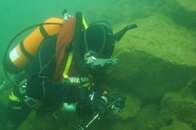Dive Plan
Dive the twin 42s with the PJ tanks (twin 42s) and abserve aquatic life with the
SeawiscopeEY.
Observations
I got into the water and swam across the channel across from the island. High Rocks water levels had dropped again since my last dive. I wanted to see whether the log that has been there for a number of years is still just below the island, but found no log. I went downstream across the current and under the rapid, which actually carried me quite fast toward the surface. Swimming head-down, I attained the bottom and driftedi with the current to deeper waters below the lifeguard stand. There I stayed on the bottom for a while, watching the sculpin. They are very territarial fish, and will challeng my gloved finger if I put it in front of them.
I did a little experiment with them, by watching very closely with my Mossback Mk3 double hose regulator, then switching to my octopus single hose regulator. As soon as I blew the bubbles (exhaled), the sculpin I was watching skedatled. It was immediate. So I tried the experiment twice more with two more sculpins. The second did not react to the single hose regulator's bubbles. The third hesitated, then left. So while not all the little sculpins were spooked, the first one definitely was.
I watched the bottom, and saw about five deep redds (nests for salmon eggs), then continued downstream. I got to a hole that was about 27 feet deep, which is deeper than I remember before. A lamprey eel was in a rock's eddie, and wedged against another rock. This one looked like it was spawned out, so I left it alone to die in peace. There was a carcus of a salmon, and several other dead lampreys too as I headed downstream.
I came under the shadow of the trail bridge above me, and knew I was getting close to the exit point. I looked at my gauge, and saw it was getting low, and so pulled the reserve rod. The tanks equalized at somewhere over 500 psig. This was an experiment too, as I wanted to see what the gauge graph looked like after I pulled the J-valve. It had been just under 300 psig, and then went up to over 500 psig, but this did not show up on the gauge, or the dive profile.
I started up to the surface when I knew I was near the right rocks, and looked up. There were two ducklings and a female duck on the surface. Slowly I surfaced beside them, and they looked at me and then climbed out of the water onto a rock. I went back down, and they entered the water again, so up I came beside them again. This time they swam downstream, and a goose with three goslings headed downstream too. I think I disturbed their nap.
When I exited, I was surprised at how easy it was with the twin 42s. They are much lighter than my twin 45s, and so getting back up to the car was much easier. I had another tank with my Scubair regulator waiting for a second dive.
Special Problems and Solutions
--This was my first dive with my Liberator dive mask after taking the corrective lenses out (LDS did it, actually--they were surprised I still had the original lenses). This black silicone mask works very well in current, and without the correction (especially the bifocals), it's much easier to walk on the rocks with the mask still on my face. The SeawiscopeEY fits this mask well, and works better without the corrections anyway. On the second dive, I dove "slick" without the SeawiscopeEY attachment to the mask.
--The Mossback Mk3 regulator is really nice to use, especially with the twin 42s as it sits in the ideal position between my shoulderblades. I have a USD Calypso octopus, and had it on a clip on my BC, but it kept coming out. So after trying unsuccessfully to tuck it into the octopus pocket (I had this designed into the Para-Sea BC) because of my gloved fingers, I simply looped it behind and between my legs. I read a hilarious account by Bill High of him putting a crab between his legs one time, with dire consequences, but the octopus worked well in this position. I should put it into the octopus pocket prior to the dive and without gloves (hard to feel velcro with gloves on).
--I got tangled in the float line again on the first dive, and could not get it loose. However, when I got into somewhat shallower water, and rolled an opposite direction, the tangle with my scuba came loose. I solved that problem on the second dive by not using the float.





